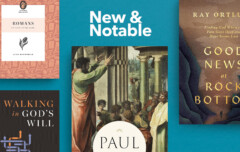Strictly speaking, to alliterate is to provide a list of words that begin with the same letter or sound, as in “Peter Piper picked a peck of pickled peppers.” In a broader sense, to alliterate is to form an outline using similarly-sounding words or phrases. It is a device that, in theory, helps readers to follow along with a book or that helps listeners to follow along with a sermon.
So, for example, Steven Lawson’s little work on Jonathan Edwards has chapters titled “The Prerequisite of Faith,” “The Priority of God’s Glory,” “The Putting Away of Sin,” “The Precipice of Eternity,” and so on. Sometimes a whole sermon series will be alliterated, as in Colin Smith’s “Faith that Lasts” which was made up of three sermons titled “Firm Foundations,” “False Assumptions,” and “Full Assurance.” But we see it most commonly in individual sermons where, as often as not, it is used to form a three-point outline. Lawson once again provides an example with his sermon on Ephesians 1:21-26 which follows this outline: Paul’s Dedication, Paul’s Dilemma, and Paul’s Decision.
(Here, for your reading pleasure, is an alliterated defense of alliteration in preaching. Or you can read Jared Wilson’s alliterated “5 C’s of Preaching.”)
Over the years I’ve seen and heard some truly wonderful examples of alliteration. I’ve also seen and heard some truly awful ones. Most recently, a book I attempted to read had maddening alliteration for its chapter headings—the kind that stretched the meaning of words far beyond the breaking point, all for the sake of maintaining a common first letter. Based on that book and a handful of recent sermons, I thought I’d share some pointers for doing alliteration well (or, at least, not doing it poorly). And, as I do so, I admit that on various occasions I’ve doubtlessly violated each of these rules.
Rule #1: Know what it’s for. Alliteration is meant to add clarity to a sermon or book by providing a simple, memorable outline. It is not meant to show off the communicator’s expansive vocabulary or clever rhyming ability. It is, at best, a minor component of a sermon and one of the least important steps in preparation. This kind of outline is only helpful if it adds clarity; it can be harmful or wasteful if it reduces clarity. Unless each alliterated heading is clear enough that it could stand on its own even if it wasn’t alliterated with the others, it is likely to hinder communication more than help it.
Rule #2: Don’t despair. Don’t despair if you aren’t good at alliterating or even particularly good at creating an outline. There are some wonderful preachers who rarely create a highly-developed, three-point outline and some who rarely alliterate (John Piper comes to mind). Many of these are still clear, powerful preachers, even though they don’t follow what some may hold up as rules for sermon preparation. They have done lots of study, they have organized the sermon in their own minds, and they are more than able to make it all make sense to their listeners.
Rule #3: Don’t give it too much time. A great outline can be a great help to a listener. You’ve heard the rule of effective communication, I’m sure: Tell them what you’re going to say, say it, then tell them what you’ve said. An outline can help listeners understand where you are going, then remind them where you’ve been. However, the great power in preaching is not in the outline, but in the faithfulness to Scripture. Don’t put a ton of time into alliterating an outline if it is going to detract from the time you’d take to search the Scriptures and prepare to faithfully exposit them.
Rule #4: Don’t use a thesaurus. If you’ve prepared a three-point sermon with two words beginning with T, there can be a great desire to find a third T-word to complete the alliterated outline. But almost invariably, turning to a thesaurus will lead you to words that are too obscure to be helpful. In general, if you can’t come up with the word on your own, it’s not a word you ought to use to frame a whole section of a sermon. A thesaurus may occasionally remind you of a word you simply forgot, but more often it will lead you to words that are too uncommon to fit the purpose. It’s better to break the alliteration than to use a word no one has spoken in 400 years.
Rule #5: It’s better not to stretch. As in rule #4, a nearly-complete outline can drive you to a kind of desperation to get that final word or two in place. If that doesn’t drive you to use a thesaurus and dig up an obscure word, it may drive you to words you know, but that aren’t quite right. You may use a word that kind of means what you want it to mean, but you would never actually use if it didn’t begin with that particular letter or have that number of syllables. It is far better to be clear than cute. If the purpose of alliteration is to help with comprehension, you’ll be working against that goal by stretching words beyond their natural meaning or usage.
The big point is that alliteration is meant to serve a purpose, and the purpose is to add clarity to the mind of a reader or listener. But done poorly, it can actually detract from clarity and hinder the understanding of a reader or listener. So my counsel is to use alliteration only when it can serve that bigger purpose (which is to say, only when it obeys at least a few of those five rules).










